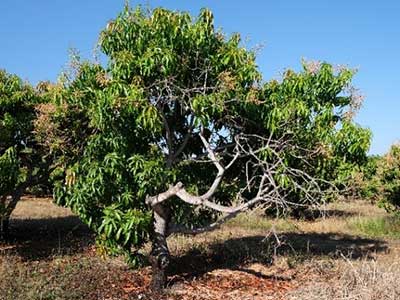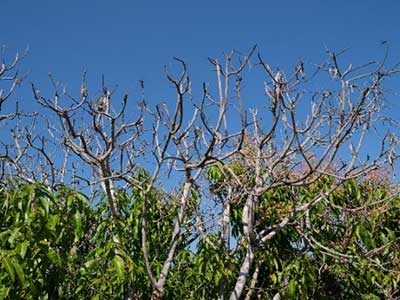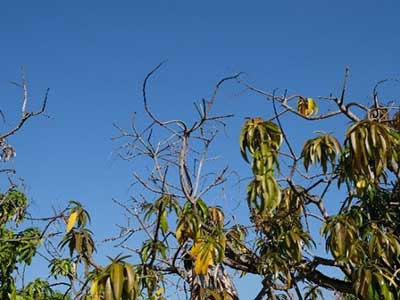Mango common dieback
Background
Botryosphaeriales is a large fungal group with about 30 genera found all over the world on virtually all types of woody plants. Many species in this group behave as endophytes under normal conditions. Endophytes colonise internal plant tissues without causing apparent harm to the host plant.
If the plant becomes stressed or physically damaged, for example in-branch wounding, this can trigger those endophytic fungi to behave as plant pathogens. The most common stressor is drought, but others include extensive physical damage, damage caused by insects or other pathogens, waterlogging, extreme heat conditions, sunburn, nutritional imbalances and unsuitable site selection for orchards.
Infections caused by endophytic fungi on woody plants are typically localised (non-systemic). A tree can be re-infected many times when these fungi enter the plant through wounds or natural openings.
Many Botryosphaeriales can cause common dieback on mango trees. This mango disease is widespread in the Greater Darwin rural area and Katherine region. Some of those fungal species also cause post-harvest stem-end rot on mango fruits. The most common species isolated from mango trees in the Northern Territory belong to the genera Lasiodiplodia, Neofusicoccum, Pseudofusicoccum and Neoscytalidium.
Symptoms
The main symptom of mango common dieback is the progressive and downward drying out or dying back of the twig/branch, sometimes with the death of the whole branch. Twig/branch/stem cankers are also a typical symptom. In very severe cases, this dieback can lead to the death of the mango tree, particularly when trees are under prolonged periods of drought with inadequate irrigation. Tree death is not common in managed orchards. Common dieback symptoms are not frequently found on young trees, its intensity appears to increase with the plant age.




Management
- Avoid mechanical injuries to the plants.
- Prevent termites and longicorn beetles causing damage to the plants.
- Reduce plant stress, including stress caused by drought and nutritional deficiencies.
- Reduce sunburn of the trunk and branches when severely pruning the trees.
- Prune dying branches by cutting the branch back to below the edge of the dead or symptomatic areas. Disinfect the pruning tool after each plant. Remove the symptomatic pruned branches from the orchard.
- Avoid pruning mango trees when the canopy is wet or during rainfall.
- Follow the ‘come clean go clean’ practices, and make sure to clean and disinfect any tree pruning machinery when moving it between farms.
- Although mango mulch is an important source of nutrients, removal of under tree mango mulch/litter in orchards with high disease load may be beneficial as it is a potential source of inoculum.
- There is no fungicide currently registered in Australia to control mango common dieback.
Further information
For more information email plant.pathology@nt.gov.au or phone 08 8999 2218.
